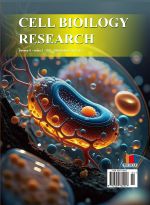Study on the Distribution of Respiratory Bacterial Communities in Patients with Pulmonary Tuberculosis
DOI:
https://doi.org/10.18063/cbr.v6i2.904Keywords:
Respiratory flora, Pulmonary tuberculosis, 16SrDNA, Sequencing technologyAbstract
Objective: This study aims to reveal the changes in the lower respiratory tract bacterial community of tuberculosis patients compared to healthy individuals. It initially explores the correlation between the lower respiratory tract microbiota and the occurrence and development of pulmonary tuberculosis, aiming to provide new reference ideas for the treatment of pulmonary tuberculosis. Methods: This research methodology is based on second-generation sequencing, targeting the V3-V4 variable region of bacterial 16S rDNA for high-throughput sequencing. The study collected bronchial epithelial brush-off samples from 11 healthy volunteers and 20 confirmed pulmonary tuberculosis patients in Yunnan Province for sequencing. Subsequently, a comparative analysis of the sequenced bacterial community results was conducted to explore the association between tuberculosis and human microecology. Results: In this experiment, 40 samples of bronchial epithelial brush-off and throat swab were collected from 20 smear-positive pulmonary tuberculosis patients. For the healthy control group, 55 samples of bronchial epithelial brush-offs were collected from five different lung segments of 11 healthy volunteers in Yunnan Province. High-throughput sequencing was performed on these samples. The results showed that the colonized flora present in the lower respiratory tract of healthy people in our province mainly includes Bacillus, Lactococcus, Enterococcus, and Streptococcus at the genus level. The results from 20 tuberculosis patients revealed that the number of lower respiratory tract flora in tuberculosis patients is richer than that of healthy people. Besides Mycobacterium tuberculosis, the dominant bacteria mainly include Prevotella, Veillonella, Pseudomonas, and Streptococcus. Although Prevotella is the dominant flora in the samples of tuberculosis patients, its abundance varies significantly among samples. Conclusion: Comparing the respiratory flora of healthy people and tuberculosis patients revealed significant differences. Not only have the types and abundance of bacteria increased significantly, but there are also unique bacterial species in the patient’s respiratory tract. This suggests that these unique bacteria are likely closely related to the occurrence and development of pulmonary tuberculosis. Furthermore, bacterial abundance may also be related to antibiotic use, providing a new direction for further research.
References
World Health Organization, 2017, Global Tuberculosis Report. World Health Organization, Geneva.
Wang L, Zhang H, Ruan Y, et al., 2014, Tuberculosis Prevalence in China, 1990–2010; A Longitudinal Analysis of National Survey Data. Lancet, 383(9934): 2057–2064.
Falzon D, Schünemann H, Harausz E, et al., 2017, World Health Organization Treatment Guidelines for Drug-Resistant Tuberculosis, 2016 Update. European Respiratory Journal, 49(3): 1602308.
Andrei M, Platon E, 2017, Drug-Resistant Tuberculosis Threatens WHO’s End-TB Strategy. Lancet Infectious Diseases, 17(7): 674.
Macallan D, Mcnurlan M, Kurpad A, et al., 1998, Whole Body Protein Metabolism in Human Pulmonary Tuberculosis and Undernutrition: Evidence for Anabolic Block in Tuberculosis. Clinical Science, 94(3): 321.
Pacchiarotta T, Deelder A, Mayboroda O, 2012, Metabolomic Investigations of Human Infections. Bioanalysis, 4(8): 919–925.
Sun L, Shen A, 2016, Application of Metabolomics in the Diagnosis, Treatment, and Etiology of Tuberculosis. Chinese Journal of Antituberculosis, 38(3): 175–179.
Inna S, Russell S, Antunes L, et al., 2010, Gut Microbiota in Health and Disease. Physiological Reviews, 90(3): 859–904.
Ley R, Peterson D, Gordon J, 2006, Ecological and Evolutionary Forces Shaping Microbial Diversity in the Human Intestine. Cell, 124: 837–848.
Chiller K, Selkin B, Murakawa G, 2002, Skin Microflora and Bacterial Infections of the Skin. Journal of Investigative Dermatology Symposium Proceedings, 6(3): 170–174.
Savage D, 1977, Microbial Ecology of the Gastrointestinal Tract. Annu Rev Microbiol, 31: 107–133.
Whitman W, Coleman D, Wiebe W, 1998, Prokaryotes: The Unseen Majority. Proc Natl Acad Sci USA, 95: 6578–6583.
Laurenzi G, Potter R, Kass E, 1961, Bacteriologic Flora of the Lower Respiratory Tract. New England Journal of Medicine, 265: 1273–1278.
Niederman M, Sarosi G, Glassroth J, 1994, Respiratory Infections: A Scientific Basis for Management. W.B. Saunders, Philadelphia.
Pecora D, 1963, A Comparison of Transtracheal Aspiration with Other Methods of Determining the Bacterial Flora of the Lower Respiratory Tract. Journal of the American Medical Association, 186(4): 263–265.
Relman D, 2002, New Technologies, Human–Microbe Interactions, and the Search for Previously Unrecognized Pathogens. The Journal of Infectious Diseases, 186(s2): S254–S258.
Costello E, Lauber C, Hamady M, et al., 2009, Bacterial Community Variation in Human Body Habitats Across Space and Time. Science, 326(5960): 1694–1697.
Jin Q, Wang H, Wang Y, et al., 2015, Effects of Neurally Adjusted Ventilatory Assist on Inflammatory Response and Weaning in Patients with Chronic Obstructive Pulmonary Disease. Chinese Journal of Emergency Medicine, 24(5): 530–535.
Yang Y, Wang J, 2010, Airway Inflammation and Treatment Prospects in Elderly Patients with Chronic Obstructive Pulmonary Disease. Chinese Gerontology, 30(1): 139–141.
Chen M, Xu H, Qi G, et al., 2016, Characteristics of Potentially Pathogenic Microorganisms in the Respiratory Tract of Patients with Stable COPD and Their Effects on Airway Inflammation. Chinese Journal of Nosocomial Infection, 26(24): 5593–5595.
Huang Y, Nelson C, Brodie E, et al., 2011, Airway Microbiota and Bronchial Hyperresponsiveness in Patients with Sub-optimally Controlled Asthma. Journal of Allergy & Clinical Immunology, 127(2): 372.
Marri P, Stern D, Wright A, et al., 2013, Asthma–Associated Differences in Microbial Composition of Induced Sputum. J Allergy Clin Immunol, 131(2): 346–352.
Blainey P, Milla C, Cornfield D, et al., 2011, Quantitative Analysis of the Human Airway Microbial Ecology Reveals a Pervasive Signature for Cystic Fibrosis. Science Translational Medicine, 4(153): 153ra130.

